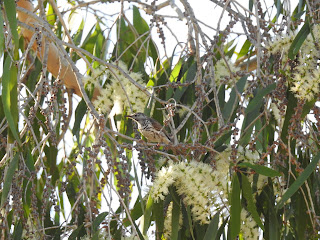One of my few breaks during the year was a 7-day birdwatching trip up to Darwin with my dad, celebrating my 18th birthday. This trip proved incredibly useful, with over 170 different species seen, a fair deal of which were lifers (their names are italicised).
The day after our late-night arrival in Darwin, we had scheduled a 2-day tour with Luke Patterson of NT Bird Specialists. I can highly recommend Luke's company and his guiding, and without him we would certainly have dipped on many of my targets.
The tour began early in the morning, with a walk around Darwin's Esplanade. Here we got onto a few of the city's commoner birds: Australian figbird, white-gaped honeyeater, Torresian imperial pigeon, spangled drongo and orange-footed scrub fowl all gave decent views. The main highlight was a roosting pair of Barking owls in trees beside a flight of stairs heading down from the Esplanade, blessedly just out in the open enough to allow decent photos and views.
BARKING OWL
We then set off on the long drive that would eventually take us to Pine Creek, making several stops along the way. Throughout the drive, black kites were abundant. Try as I might, I did not manage to pick out any black-breasted buzzards among them.Our first stop was at Howard Springs Nature Park, a site containing wet rainforest where rainbow pitta could sometimes be seen. Though we dipped on the pitta here, we got our first looks at brown whistler, crimson finch, rainbow bee-eater, varied triller, blue-winged kookaburra and yellow oriole. A pair of nesting large-billed gerygones allowed surprisingly good views, and the highlight was a quiet rose-crowned fruit dove perched high in the canopy. A little pied cormorant perched high on a tree stump in the rainforest looked very out of place, likely having flown there from the nearby lake, around which a lone Merten's water monitor and a few little pied and little black cormorants were basking in the sun. We ate breakfast here, with a few rather tame silver-backed butcherbirds hungrily eyeing our food.
LARGE-BILLED GERYGONE
ROSE-CROWNED FRUIT DOVE
RAINBOW BEE-EATER
SILVER-BACKED BUTCHERBIRD
MERTEN'S WATER MONITOR
We next stopped near Adelaide River at a familiar place, a water treatment plant. Here, as always seems to be the case, the plant had attracted a myriad of waterbirds. Most common were plumed whistling-ducks, but a lone Radjah shelduck, a few pink-eared ducks and a pair of Australasian shovelers were also present. On the water were some Australasian grebes, and black-fronted dotterels fed at the water's edge. The dry woodland around the plant gave us our first looks at a few common species we'd see most days after this: dusky myzomela, white-throated honeyeater and peaceful dove.
PLUMED WHISTLING-DUCK
PEACEFUL DOVE
We ate lunch in a picnic ground at Adelaide River. Around this were many lemon-bellied flycatchers, a sacred kingfisher, more white-throated honeyeaters and the first rufous-banded honeyeater of the trip.
SACRED KINGFISHER
LEMON-BELLIED FLYCATCHER
One more brief stop was made at a few pools of water beside the road to Pine Creek, where the first black-necked storks of the trip were observed, along with a white-necked heron, a royal spoonbill and some Radjah shelducks.We arrived at Pine Creek and immediately checked into our accomodation, the Pine Creek Railway Resort. The rooms here were good and the shower was much-appreciated after our drive, although we somehow managed to jam the door before dinner, and had to be rescued by Luke.
After a brief rest, we all gathered together to explore the town. Flowering trees held white-quilled honeyeaters, little friarbirds, white-gaped honeyeaters and bar-breasted honeyeaters. White-breasted woodswallows perched on wires. A family of grey-crowned babblers chattered noisily to themselves as they fed, and a great bowerbird was seen flaring its pink crest in front of its bower, hoping to attract a nearby female.
BAR-BREASTED HONEYEATER
WHITE-QUILLED HONEYEATER
WHITE-GAPED HONEYEATER
Our main target at Pine Creek was the resident hooded parrot population, and these did not disappoint. Not only did we get brilliant views of a massive flock feeding right in front of us on some recently burned grassland, but a stunning male bird drinking from a tap proved very photogenic. I could not have asked for a better first sighting of this species, one of the Northern Territory's few endemics.
HOODED PARROT
A final walk around some lilypad-infested ponds added yellow-tinted honeyeater and paperbark flycatcher to the already-impressive trip list. We ate dinner at a local pub, which was having a pizza night. We briefly attempted a spotlighting drive along a nearby road, but were unsuccessful, seeing only a tawny frogmouth and none of the hoped-for buttonquails. Satisfied with the day, we slept well, exhausted as we were with the day's efforts.














No comments:
Post a Comment